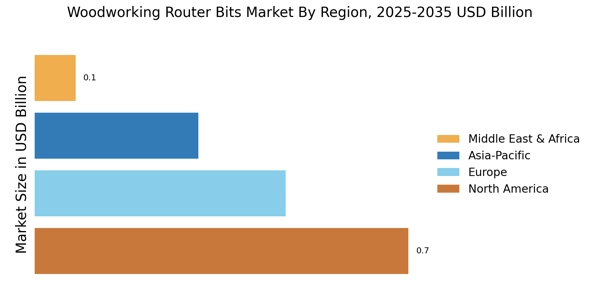Increase in Home Renovation Projects
The Woodworking Router Bits Market is experiencing a notable surge due to the increase in home renovation projects. As homeowners seek to enhance their living spaces, the demand for precision tools, including router bits, has escalated. According to recent data, the home improvement sector has seen a growth rate of approximately 5% annually, which directly influences the woodworking tools market. This trend is further fueled by the rise of online platforms that provide easy access to woodworking supplies, enabling consumers to undertake DIY projects. Consequently, the Woodworking Router Bits Market is poised to benefit from this growing interest in home renovations, as more individuals invest in quality tools to achieve professional results in their projects.
Technological Innovations in Tool Design
The Woodworking Router Bits Market is witnessing a transformation due to technological innovations in tool design. Advances in materials and manufacturing processes have led to the development of more efficient and durable router bits. For instance, the introduction of carbide-tipped bits has enhanced cutting performance and longevity, appealing to both professionals and hobbyists. Furthermore, the integration of CNC technology in woodworking has increased the demand for specialized router bits that can accommodate complex designs. As these innovations continue to evolve, the Woodworking Router Bits Market is expected to expand, as users seek tools that offer improved performance and versatility.
Growing Emphasis on Sustainable Practices
The Woodworking Router Bits Market is increasingly influenced by the growing emphasis on sustainable practices within the woodworking sector. Consumers are becoming more environmentally conscious, leading to a demand for tools that are produced using sustainable materials and processes. This shift is prompting manufacturers to innovate and offer router bits that align with eco-friendly standards. Recent surveys indicate that approximately 60% of consumers prefer to purchase products from companies that demonstrate a commitment to sustainability. As a result, the Woodworking Router Bits Market is likely to experience growth as manufacturers adapt to these changing consumer preferences and invest in sustainable production methods.
Rising Popularity of Woodworking as a Hobby
The Woodworking Router Bits Market is benefiting from the rising popularity of woodworking as a hobby among various demographics. More individuals are engaging in woodworking activities, driven by a desire for creativity and craftsmanship. This trend is particularly evident among younger generations who are increasingly interested in hands-on projects. Market Research Future suggests that the number of woodworking enthusiasts has increased by approximately 10% in recent years, leading to a higher demand for quality router bits. As hobbyists seek to invest in reliable tools, the Woodworking Router Bits Market is likely to see sustained growth, as these consumers prioritize precision and durability in their woodworking endeavors.
Expansion of the Furniture Manufacturing Sector
The Woodworking Router Bits Market is significantly impacted by the expansion of the furniture manufacturing sector. As the demand for custom and high-quality furniture increases, manufacturers are increasingly relying on advanced woodworking tools, including router bits, to meet consumer expectations. Recent statistics indicate that the furniture manufacturing industry has been growing at a rate of around 4% per year, driven by changing consumer preferences for personalized and sustainable products. This growth necessitates the use of specialized router bits that can create intricate designs and finishes. Therefore, the Woodworking Router Bits Market stands to gain from the ongoing expansion of furniture production, as manufacturers seek to enhance their capabilities and efficiency.


















Leave a Comment